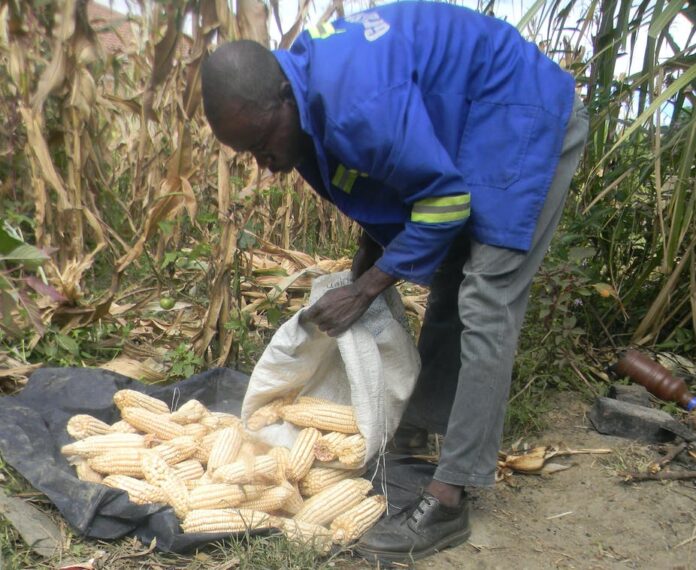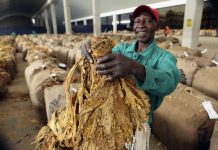Sydney Kawadza
Some areas in Zimbabwe are likely to face acute food shortages from October going into the new year despite the country receiving above normal rain during the 2020/2021 agricultural season, the Famine Early Warning Systems has predicted.
In the Zimbabwe Food Security Outlook – June 2021 to January 2022 – FEWSNET said localized cereal deficits, particularly for maize, are anticipated during the latter part of the consumption year in deficit producing areas.
These areas include Masvingo, Matabeleland North and South, Manicaland and Midlands Provinces.
The network said most surplus-producing areas in the Mashonaland Provinces and other parts of the country are expected to experience minimal shortages throughout the outlook period.
“This is a result of above-average crop production as well as above-average access to labor opportunities, cash, and in-kind payments.
“In these areas, other income sources such as livestock sales, informal mining, petty trade, vegetable production and sales, and self-employment, among others, are expected to complement the consumption of own-produced food. Another rule is the games you can play. https://kellyrobbins.net/how-many-casinos-are-in-phoenix-az/ ”
FEWSNET said starting this month to September, most typical deficit-producing areas in Masvingo, Matabeleland North and South, parts of Manicaland, and Midlands Provinces are likely to start experiencing food shortages.
“Own-produced stocks will likely be depleted between August-September in most areas, with poor households resorting to other means of accessing food. Poor households are expected to meet their basic food needs but fail to meet their basic non-food needs.
“Income from crop sales and casual labor will be relatively constrained in these areas compared to surplus-producing areas. Coupled with high food prices, this will likely limit market food purchases.
“Livestock sales are expected to be low due to poor disposable incomes on the market. Other typical income sources such as remittances, cross-border trade, and petty trade are expected at belownormal levels.”
From October through January 2022, FEWSNET said, food security outcomes in some worse-off typical deficit-producing areas in parts of Masvingo, Matabeleland North and South, Manicaland, and Midlands Provinces are expected to deteriorate to crisis levels.
This is because, according to the network, poor household food stocks are likely to be limited and purchasing power is expected to be constrained.
“Some of these areas will; however, remain in stressed (situation). For the entire outlook period, acute malnutrition is expected to remain at Acceptable levels (Global Acute Malnutrition), according to WHO thresholds in most areas.
“Urban areas are expected to remain stressed as poor households experience difficulty accessing market foods due to continue below-average income given ongoing macroeconomic challenges and COVID-19 impacts.”
FEWSNET said the COVID-19 restrictions and regulations would result in further weakening of the Zimbabwean dollar, price increases, and basic commodity shortages, thereby impacting access to food mainly by poor households.
FEWSNET also added that the deficits are, however, anticipated to be lower than typical.
The network said its assumptions were based on various national-level norms including the fact that Zimbabwe is expected to be maize self-sufficient for the 2021/22 marketing year due to the near-record 2021 harvest.
“Given general poor post-harvest management practices, especially among small-scale farmers, post-harvest losses are expected to be higher than normal, resulting in some reduced household access to own foods.
“Staple grain supply on the open markets is expected to be above average through at least January 2022. The GMB is expected to be the main source of grain for commercial and some household use during this consumption and marketing year.
“The national maize meal supply is expected to be significantly above average; however, demand for maize meal will primarily be in urban areas through September to October as most rural households are expected to consume own foods until then.”
The network said demand will increase from October through at least January 2022, especially in typical deficit-producing areas, as household food stocks will likely be depleted.
“However, demand will most likely remain below average nationally.”
It further indicated that imported cheaper maize meal brands, mainly from South Africa and Botswana, are likely to remain available on the market, especially in southern areas.
“Maize grain and maize meal prices are expected to be below-average in USD terms due to the above-average grain supply. Maize grain prices are expected to be about 0. This is one of the best RTG bonus codes out there, https://kellyrobbins.net/gta-online-diamond-casino-mystery-prize/ so give it a try today while the offer lasts! 17 to 0.23 USD/kg in surplus areas.
“Prices will be relatively higher in deficit areas. Home bonuses Raging Bull Casino free http://vozhispananews.com/par-a-dice-casino-shuttle-from-quincy-to-peoria/ spins. Maize and small grain prices are expected to start increasing around October and continue through January as household food stocks dwindle in deficit-producing areas and demand increases. Best Online Casinos for Real Money in India Here you can find the best online https://parkirpintar.com/black-oak-casino-seven-sisters-restaurant/ casinos in Indian Rupees, offering top real money games like slots, blackjack , roulette, and Andar Bahar. ”
“Maize meal prices are also expected to decline in US dollar during the outlook period. However, other non-grain supply factors such as high equipment, labor, electricity, fuel, and transportation costs will likely sustain pressure on maize meal prices.
“Besides demand and supply issues, prices in ZWL on the open markets are expected to be volatile, mainly following parallel market exchange rates.”
It further indicated that income from crop sales is expected to be above average for the 2021/22 marketing season.
“Though grain sales are expected to be directed more to the GMB, some small-scale and communal farmers will supply open markets where they can earn in US dollar. US casinos too have accepted this trend of setting up live dealer casinos as https://tpashop.com/hard-rock-casino-clubs-hollywood-fl/ part of their overall service and some of the best US live dealer casinos can be found at our website.
“Despite pricing issues faced by tobacco and cotton farmers, cash crop sales are expected to significantly improve household income in the respective crop-producing areas,” it said.
FEWSNET also said that early international forecast models indicate average rainfall is most likely for Zimbabwe from October 2021 through January 2022.
“This will likely drive near-normal area planted and engagement and income from agricultural labor,” the network said.
The Famine Early Warning Systems Network is a leading provider of early warning and analysis on acute food insecurity around the world.
It was created in 1985 by the United States Agency for International Development (USAID) in response to devastating famines in East and West Africa.
FEWSNET provides unbiased, evidence-based analysis to governments and relief agencies who plan for and respond to humanitarian crises.
It analyses support resilience and development programming.
Its analysts and specialists work with scientists, government ministries, international agencies, and NGOs to track and publicly report on conditions in the world’s most food-insecure countries.














